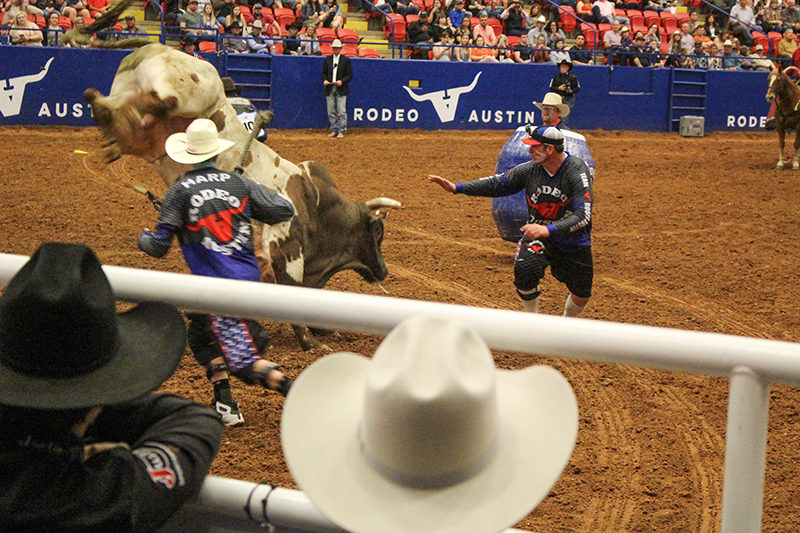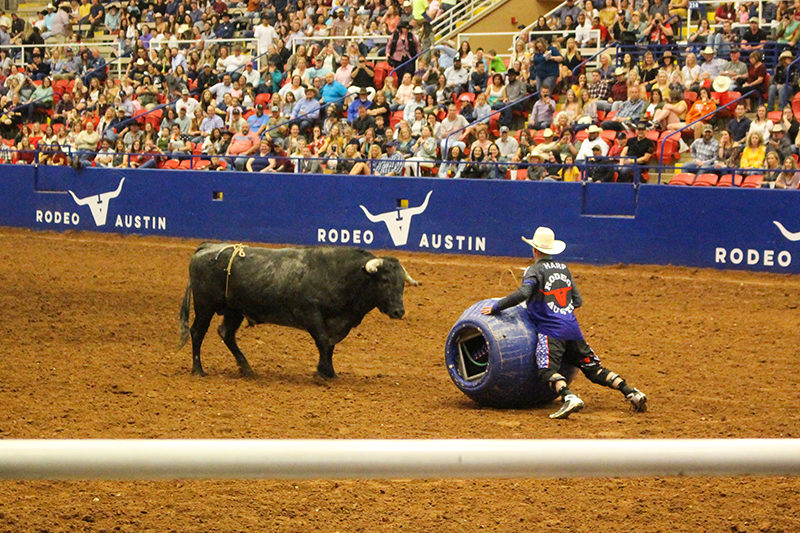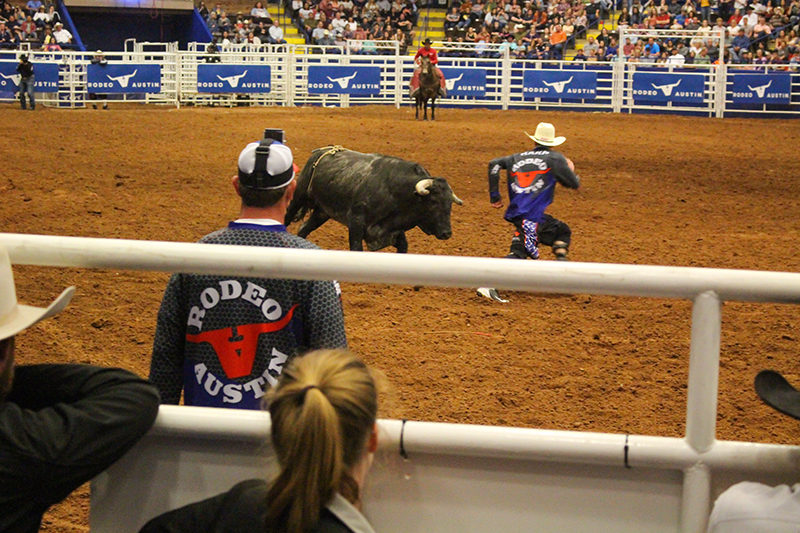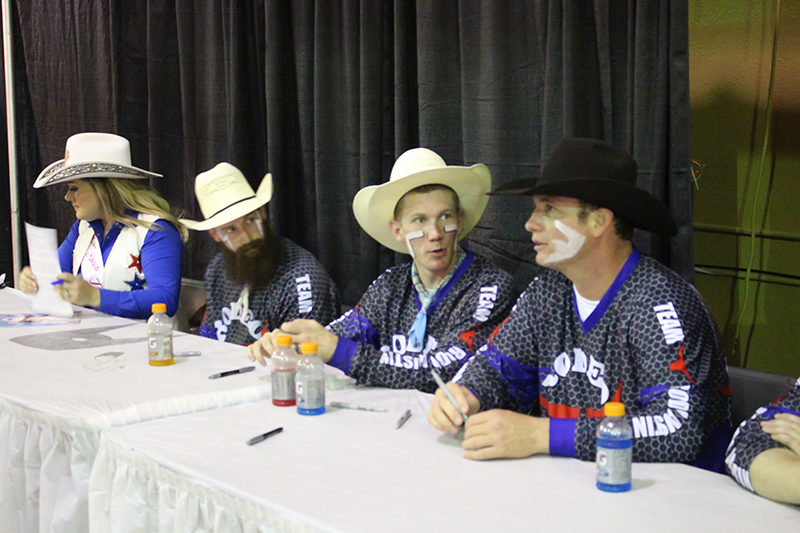Rodeo Bullfighters Find Fulfillment and Friendship on a Long, Hard Road
By Robert Larkin
Reporting Texas

Nathan Harp, left and Evan Allard help distract a bull during Rodeo Austin at the Travis County Exposition Center. Robert Larkin/Reporting Texas
Under the Travis County Exposition Center, there’s a small room behind a green door tucked back in the corner of a hallway. It’s a nondescript nook – maybe six people could fit comfortably inside – and its concrete floors, black plastic chairs and fluorescent lights reinforce a gloomy vibe.
During Rodeo Austin, a two-week event that takes place in mid-March at the Travis County Expo Center, however, three men sit inside the room and brighten it with their laughter and good-natured tales while their knee braces, sweaty cleats and knee pads decorate the floor. Meet rodeo bullfighters Evan Allard, Nathan Harp and Weston Rutkowski. In locker rooms like these across the country, the three men have built a friendship that transcends state borders while performing one of the most dangerous lines of work in American sports.
Every night during their Austin run, Allard, 30, and Harp and Rutkowski, both 29, used their bodies to protect participants in bull riding, the rodeo’s primetime event. Should the rider fall from the bucking bovine in less than the qualifying eight seconds, or when he or she is executing a successful dismount, the bullfighters swing into action. Putting their own health and safety aside, they distract the bull with techniques ranging from running at it, tricking it to go in a different direction or sometimes directly taking a hit.
No wonder their bond is a close one. “You have a family at home, but you develop a rodeo family,” Harp said. “When I have problems at home, I have these guys praying for me like I would have a sister back home. It’s amazing the family you develop.”
“You can go through my phone and see not many contacts that weren’t from rodeo,” Allard adds.
The three friends prepare for their jobs in different ways.

Nathan Harp toys with a bull during a one-on-one bullfight at Rodeo Austin. Robert Larkin/Reporting Texas
Harp, a fair-skinned and lean man from Tuttle, Okla., focuses on mental preparation. The sunburned and muscular Allard works constantly around his house in Vinita, Okla., to stay in shape for his nights on the rodeo circuit. Rutkowski, a Haskel, Texas, native, likes to lift weights, and his southern drawl and thick black beard make him seem like a character straight from a Western movie.
Each of the three fall into the general category of rodeo clown, but their job and preparation sharply differs from colleagues who pull funny tricks on the rodeo dirt. To be sure, they put on a uniform and paint their faces before an event, but their skill makes them athletes in their own right.
Their job calls for peak physical shape, requiring the speed and quickness to distract a bull and also the strength to deflect a hook, or a sudden jerk of its sharp horns. In addition, it requires the discipline to know when to step forward and help the rider and what angles to cover. All the while, the bullfighters are moving in ankle-deep dirt.
Given the work they do, getting injured in the rodeo isn’t a matter of if, but when, the three men agree. Missing an event because of injury means no money. So, learning to take the pain and keeping working is just as important as learning how to handle a bull.
“They don’t consider a broken arm or a broken leg an injury – it’s being gored,” rodeo historian Gail Woerner said. “They better be the kind of guy that can work hurt and be there anyway.”
Despite such hardships, veterans like Allard, Harp and Rutkowski can expect prolonged careers in their profession. According to Woerner, a career can typically last 20 years absent severe injury. But that longevity doesn’t necessarily mean bullfighters earn what they’re worth, Woerner says.

Evan Allard, foreground, watches on as Nathan Harp participates in a bullfight. Robert Larking/Reporting Texas
Bullfighters who perform at the top rodeos can expect $1,400 per performance, but that total doesn’t apply for every show across the country. Of the 127 bullfighters who participated in at least one Pro Rodeo Cowboy Association event last year, many eke out the barest of incomes.
Allard, Harp and Rutkowski can make a good living because of their star power, but those starting out will often work two or more jobs. According to the website Job Monkey, a bullfighter can expect to make $50,000 per year, but numbers vary widely.
But when the bull riding event begins, financial concerns fly out the window. Once the bull rider falls, the bullfighters jump in and surround the bull. Bullfighting is a beautiful dance. It requires taking precise steps and establishing synchronicity with teammates to know where they will be and what angles to take. Chaos abounds, and the bullfighters must learn how to handle that particular bull’s jerking movements and then act in a matter of seconds.
One small slip — a missed angle, a false step, a miscommunication — can result in severe injury. “Basically we’re in charge of a car crash,” Rutkowski said. “When that rider starts to fall off, you can notice the rider is starting to lose position and you can start to step forward. But you can’t take too many steps because you might cause him to fall a different way.”
Allard, Harp and Rutkowski have all worked as bullfighters since at least their early 20s. The job takes them around the country and away from their families for much of the year, and their stories could fill a medical textbook. Rutkowski destroyed his ankle in Austin in 2015, shredding the ligaments inside. Harp has torn a knee and broken an arm. And Allard has blown out both knees in his 15-year career. Even though the sport involves taking on a massive bull, the men wear minimal protective gear under their loose-fitting clothes.
So what keeps them in the game?
“You can go into an office job and do the same thing nine to five, five days a week,” Harp said. “For us, we don’t know what’s going to happen. We might have to get hooked five times or we might not do nothing.”
“It’s just a love for what you do,” Rutkowski said. “We’re our own boss … We do our own booking, answering to ourselves. Our only job is getting up and going to work.”

From left, Weston Rutkowski, Nathan Harp and Evan Allard sign autographs following Rodeo Austin. Robert Larkin/Reporting Texas
Eventually, it becomes a point of pride to save not only yourself, but also your rider and the other bullfighters. “We would rather live with the pain than regret,” Harp said. “It hurts more to see your buddy get hooked than you.”
That sense of community carries the three through every stop they take. Harp says when a knee injury sidelined him for six months, he began to miss his friends on the road like he misses his family when he’s out performing. Even though they don’t work every rodeo together, they’re able to connect on a handful of stops, like in Austin.
And while their passion for the rodeo defines them, it’s not the great saves or tough bulls they fought they’re going to remember most fondly, they say. It’s the memories and friendships they shared together.
“I’ve worked rodeos where I wasn’t friends, and I didn’t have those memories,” Allard said.
“We’ll remember the great bullfights and the great saves, but it’s going to be the time Evan chased me down or Weston did this or … that,” Harp said.
“It’s [a] cliché, but it’s not the years, it’s the miles,” Rutkowski said.